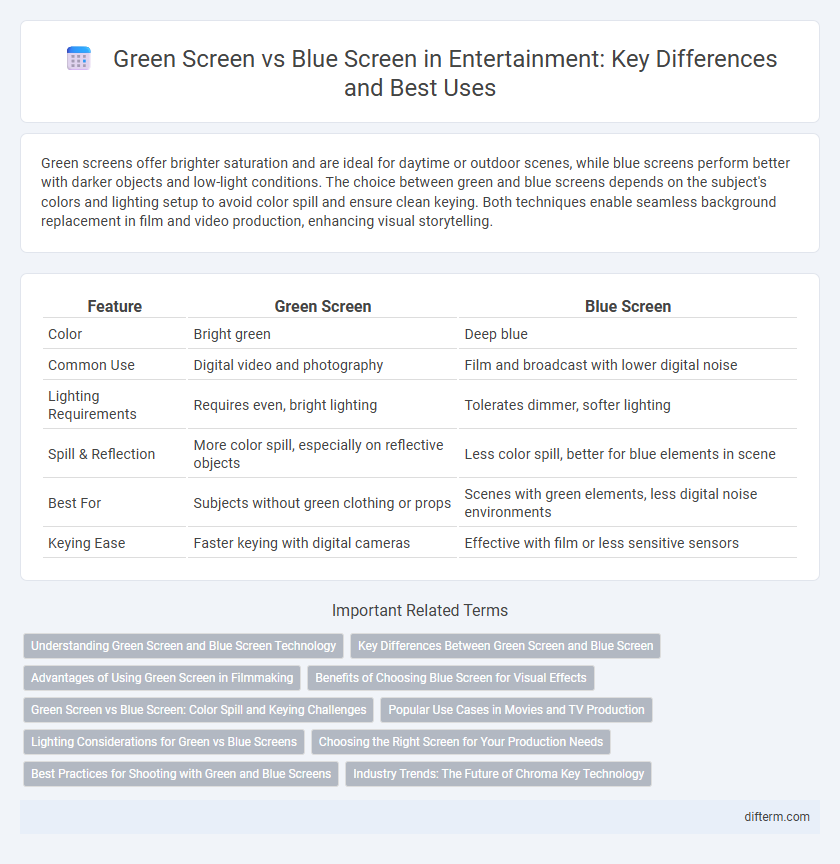Green screens offer brighter saturation and are ideal for daytime or outdoor scenes, while blue screens perform better with darker objects and low-light conditions. The choice between green and blue screens depends on the subject's colors and lighting setup to avoid color spill and ensure clean keying. Both techniques enable seamless background replacement in film and video production, enhancing visual storytelling.
Table of Comparison
| Feature | Green Screen | Blue Screen |
|---|---|---|
| Color | Bright green | Deep blue |
| Common Use | Digital video and photography | Film and broadcast with lower digital noise |
| Lighting Requirements | Requires even, bright lighting | Tolerates dimmer, softer lighting |
| Spill & Reflection | More color spill, especially on reflective objects | Less color spill, better for blue elements in scene |
| Best For | Subjects without green clothing or props | Scenes with green elements, less digital noise environments |
| Keying Ease | Faster keying with digital cameras | Effective with film or less sensitive sensors |
Understanding Green Screen and Blue Screen Technology
Green screen and blue screen technologies are key tools in visual effects, enabling filmmakers to composite different backgrounds seamlessly. Green screens are preferred for daytime or outdoor scenes due to their brighter color and less likelihood of matching common wardrobe colors, while blue screens are favored for night scenes or when subjects wear green. Both technologies rely on chroma keying to isolate and replace the chosen color background, enhancing creative possibilities in entertainment production.
Key Differences Between Green Screen and Blue Screen
Green screen and blue screen are both chroma key techniques used for background replacement in film and video production, with green screens being preferred for their higher luminance, which makes them easier to key out in digital cameras. Blue screens are often chosen when the subject contains green elements, as blue is less likely to cause color spill on the foreground subject. Moreover, green screens perform better in low-light conditions due to their brightness, while blue screens excel in high-contrast scenes and are commonly used in traditional film stock.
Advantages of Using Green Screen in Filmmaking
Green screens offer superior luminance and are less likely to cause color spill on actors, enhancing the clarity and precision of keying in post-production. Their widespread use in digital cameras, which are more sensitive to green, results in cleaner and more efficient compositing. The availability of vibrant, easily adjustable green hues makes green screens ideal for a diverse range of lighting setups and visual effects in filmmaking.
Benefits of Choosing Blue Screen for Visual Effects
Blue screen technology provides superior contrast when filming subjects with warmer tones, ensuring cleaner keying in visual effects. It minimizes color spill on skin tones, which is especially beneficial for actors with red or orange costumes. This leads to more precise compositing and enhanced final image quality in post-production.
Green Screen vs Blue Screen: Color Spill and Keying Challenges
Green screen offers superior keying with less color spill on subjects compared to blue screen, as green wavelengths are less likely to reflect onto skin tones. Blue screens excel in darker costume or prop scenarios since blue pigments absorb light differently, reducing shadows but are more prone to color spill in bright environments. Effective chroma keying demands selecting the optimal screen color based on subject colors and lighting conditions to minimize post-production keying challenges.
Popular Use Cases in Movies and TV Production
Green screens dominate in movies and TV production due to their compatibility with digital cameras and effectiveness in replacing backgrounds during post-production, especially for outdoor scenes. Blue screens remain favored for scenes involving humans or reflective objects, as blue contrasts better with skin tones and costumes, reducing color spill. Both techniques are essential in visual effects, but green screens are more commonly used for their vibrant hue and ease of keying in modern CGI workflows.
Lighting Considerations for Green vs Blue Screens
Green screens require less lighting since their brighter hue requires less intensity to evenly illuminate, reducing shadows and hotspots on set. Blue screens demand more precise and intense lighting to avoid color spill and maintain a consistent chroma key, especially in low-light environments. Proper diffusion and balanced lighting setups are essential for both, but green screens generally offer easier and more flexible lighting conditions for filmmakers.
Choosing the Right Screen for Your Production Needs
Choosing the right screen color depends on the subject's wardrobe and skin tones, with green screens favored for their brightness and suitability for digital cameras, while blue screens work better with low-light scenes and less reflective materials. Green screens provide higher luminance, making keying easier in post-production, whereas blue screens offer a cleaner key for dark or reflective objects due to less color spill. Understanding your production environment and digital or film camera sensitivity ensures optimal chroma keying results and seamless visual effects integration.
Best Practices for Shooting with Green and Blue Screens
Optimal lighting is crucial when shooting with green and blue screens to avoid shadows and color spill, ensuring clean keying in post-production. Selecting the screen color depends on the subject's wardrobe and skin tones, with green favored for daylight scenes and blue for darker props or costumes. Maintaining proper distance between the subject and the screen minimizes reflections, improving the quality of chroma key effects in film and video production.
Industry Trends: The Future of Chroma Key Technology
Chroma key technology is rapidly evolving, with industry trends favoring green screens for their superior luminance and ease of digital keying in high-resolution video production. Advances in software algorithms now enable more precise edge detection and color spill suppression, expanding the utility of blue screens for costumes and props containing green elements. Emerging LED volume stages are blending traditional chroma keying with real-time virtual environments, signaling a transformative shift in how filmmakers integrate live-action and CGI elements.
green screen vs blue screen Infographic

 difterm.com
difterm.com